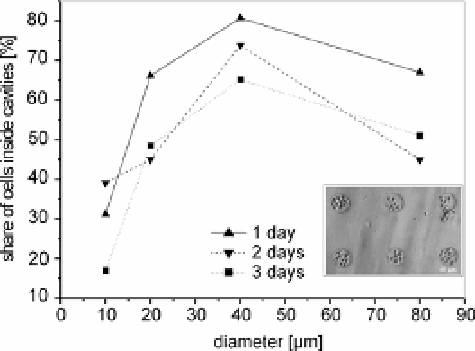Biomedical Engineering Reference
In-Depth Information
Fig. 10
Adhesion of hematopoietic stem cells to micrometer-sized cavities. The relative
amount of cells inside the cavities in comparison to all cells on the surface after 1 to
3daysofcellculture
procedure allows a coating without chemical activation or irradiation and
thus conserves the structural and functional features of the biopolymers and
the underlying polymer substrate.
5
Perspective: Bio-Hybrid Extracellular Matrices
The previous section referred to systems in which ECM biopolymers inter-
act with solid surfaces, in particular those of synthetic polymer materials,
and could be modulated with respect to structure formation and functional-
ity. Although the options of this approach deserve further attention the use of
synthetic macromolecules in the engineering of ECM structures was recently
shown to enable a level of interaction beyond this. Biohybrid polymer struc-
tures containing both synthetic and natural or synthetic and bio-analogous
components have been introduced by the pioneering studies of a number of re-
searchers. The rational of this concept concerns the functional characteristics
of the resulting matrices, e.g. to stress certain desired functions more then natu-
ral or truly biomimetic matrices would allow, as well as several practical aspects
related to processing and safety of the matrices. The term “biohybrid” is con-
sidered here to cover a range of rather different structures including chemically
modified biopolymers (e.g. for crosslinking or decoration with active units) as
well as synthetic hydrogels with bioactive (biomimetic) building blocks such as
peptides triggering adhesion or enzymatic cleavage.
Jeffrey A. Hubbell pioneered the field of biomimetic polymer structures
emphasizing the idea of responsiveness to cellular stimuli through the com-
bination of a variety of incorporated bioactive building blocks [114]. He often
utilized conjugate addition reactions of poly(ethylene glycol) (PEG) units and

